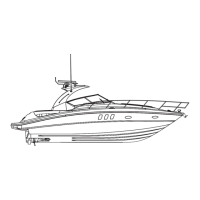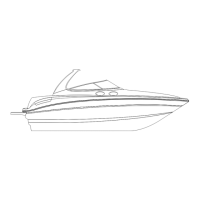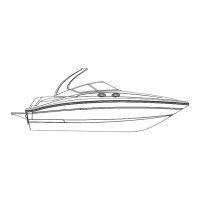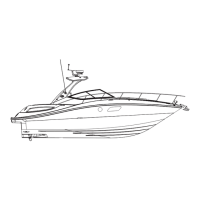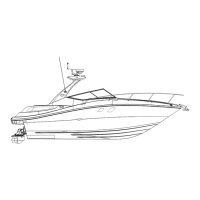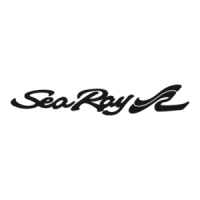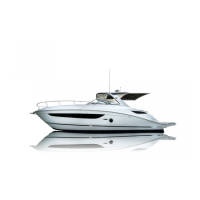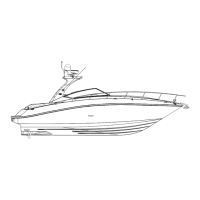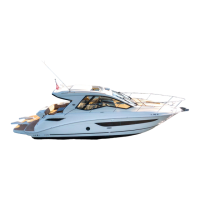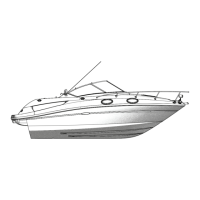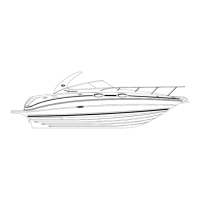Do you have a question about the Sea Ray 340 Sundancer and is the answer not in the manual?
Outlines operator duties for safety, including taking courses and understanding boat handling rules.
Advises taking the boat to an authorized Sea Ray dealer for service and outlines the process for unresolved issues.
Defines safe boating practices, including knowing limitations and following rules of the road.
Explains the importance of safety precautions and labels, advising against removal or obstruction.
Lists minimum U.S. Coast Guard required equipment for boats 26' to 40', including PFDs and signaling devices.
Describes the automatic fire extinguisher system in the engine compartment and its indicator light.
Warns about carbon monoxide dangers, symptoms, and preventative measures like ventilation.
Details requirements for personal flotation devices (PFDs) and throwable devices for all occupants.
Lists recommended items for safe boating, especially when out of sight of land, like first aid and charts.
Warns that drugs and alcohol impair boat operation ability, leading to accidents and deaths.
Explains the certification plate's load limits and advises reducing capacity in adverse conditions.
Advises not to exceed the maximum engine power rating for vessel handling and stability.
Emphasizes the need for constant operator awareness of surroundings and adjusting speed for visibility.
Details boat design categories for weather conditions and provides weather-related safety rules.
Covers emergency procedures for medical situations, water rescue, fire, flooding, collisions, grounding, and engine failure.
Provides guidelines for safe docking, lifting, and storing the boat, including sling placement.
Advises on safe passenger placement within the boat, especially during movement or emergencies.
Illustrates the general layout of the boat's upper deck, including key features and components.
Details the layout of the mid-deck and cabin areas, showing component locations.
Provides an overview of the helm station, including gauge panels and switch layouts.
Identifies and explains the function of various thru-hull cutouts on the boat.
Explains the operation of key boat controls, including gear shift and throttle.
Covers the engine alarm system, which indicates problems with temperature, oil pressure, or stern drive oil.
Explains the function of critical boat gauges like tachometers, oil pressure, and water temperature.
Introduces the SmartCraft instrumentation system for comprehensive engine and boat data display.
Describes the optional SmartCraft System View display for integrated boat information and diagnostics.
Details the mandatory use of navigation and anchor lights from sunset to sunrise or in reduced visibility.
Provides a critical checklist for pre-launch, in-water, and post-launch procedures for safe operation.
Outlines essential safety precautions for fueling, including no smoking and proper nozzle contact.
Emphasizes the requirement for PFDs for all passengers, especially children and non-swimmers.
Stresses the importance of instructing passengers on boat behavior and safe seating.
Provides pre-start reminders, including checking for gasoline fumes and engine compartment ventilation.
Describes the hydraulic steering system, its maintenance, and potential issues.
Warns against discharging fuel or oily waste and provides guidance on cleanup and disposal.
Details bilge pump operation, maintenance, and troubleshooting for water removal.
Explains the function of bilge blowers in preventing explosive gasoline fumes before engine start.
Highlights the importance of engine attention, maintenance, and compliance with manufacturer manuals.
Describes the standard gasoline fuel system, including tanks, vents, and electric fuel valves.
Covers maintenance for diesel fuel filters, including draining water and replacing elements.
Provides crucial safety precautions for fueling, including checking labels and avoiding spills.
Introduces the 12-volt DC electrical system, power sources, and battery maintenance.
Explains the DC system, power derivation from batteries, and voltmeter locations.
Details battery selection, installation, and critical safety warnings regarding sparks and fumes.
Locates the main DC breaker panel in the engine room and lists its equipment and battery switches.
Details the controls and functions of the cabin DC distribution panel, including breaker functions.
Explains the illuminated waterproof electronic switch pads and their connection to Electronic Interface Modules (EIMs).
Explains the 120V/60Hz and optional 220V/50Hz AC systems, including wiring and hazards.
Provides procedures for connecting and disconnecting shore power, including safety precautions.
Step-by-step guide for connecting and energizing the boat's AC system from shore power.
Procedure for energizing the boat's AC system from the main distribution panel.
Step-by-step guide for safely disconnecting the boat's AC system from shore power.
Details the controls and functions of the cabin 120V AC main distribution panel.
Explains the automatic battery charger/converter, its modes, and charging characteristics.
Locates the GFI receptacle and warns about its limitations and potential hazards.
Urges compliance with generator manufacturer's manual for maintenance and warranty.
Provides steps for starting the generator, including pre-start checks and panel operations.
Details the procedure for starting the generator using the cabin 12V DC distribution panel.
Provides steps for safely switching the boat's power source from shore to generator.
Explains the procedure for stopping the generator, including turning off breakers and cooling down.
Details the carbon monoxide monitor, its function, alerts, and testing procedure.
Describes the air conditioning/heating system, its size, capacity, and filter maintenance.
Details the fresh water system components and initial operation procedures.
Details the water heater operation, safety warnings, and maintenance for freezing prevention.
Introduces the various head system options available and emphasizes reading related sections.
Explains the VacuFlush head system, its operation, and the necessary breakers.
Details the automatic fire extinguisher system, its activation, and immediate post-actuation procedures.
Explains how to manually activate the engine room fire extinguisher using the pull handle.
Summarizes routine inspection, service, and maintenance activities for boat systems.
Outlines inspection protocols for key boat areas like bilge, engine, and fuel systems.
Details bilge area inspection, including limber holes, pump float switch, and cleaning.
Covers engine checks for dust, grease, nuts/bolts, belts, wiring, and battery cables.
Guides on inspecting the fuel system for leaks, testing fittings, and cleaning filters/vents.
Provides a checklist for winterizing the boat, covering storage, engines, and batteries.
Covers head system flushing, holding tank pumping, and winterizing procedures.
Explains water system operation, draining, and winterizing using air pressure or antifreeze.
Provides fueling instructions for gasoline and diesel, including stabilizer and running engines.
Guides on preparing the boat after storage, covering fuel systems, batteries, and miscellaneous checks.
Provides a checklist for pre-departure, underway, and returning to port procedures.
Checklist for general items, boat systems, and engine status before boarding and departing.
Checklist for preparing the boat before departure and after launching.
Checklist for ensuring passengers are safe, systems are working, and engine operation is normal.
Checklist for procedures when returning to port, including securing the boat and systems.
Checklist for securing the boat, including lines, shore power, seacocks, and switches.
Troubleshooting guide for engine starting issues, covering no response and no ignition scenarios.
Provides procedures for starting and stopping the generator, including safety precautions.
Details proper cleaning and waxing procedures for fiberglass and gelcoat surfaces.
| Length Overall | 35'6" |
|---|---|
| Fuel Capacity | 225 gal |
| Holding Tank Capacity | 28 gal |
| Dead Rise | 21° |
| Sleeping Capacity | 6 |
